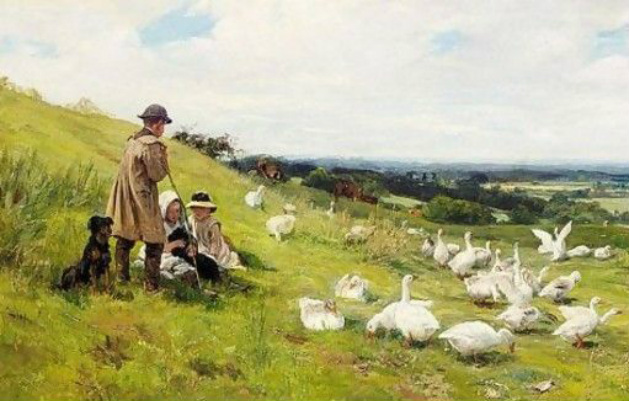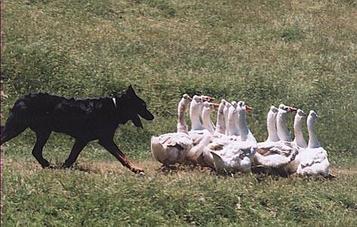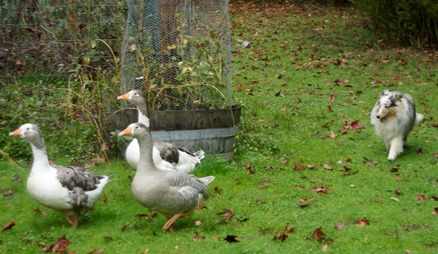
|

|
|
WORKING WITH GEESE Geese aren’t as common as some of the other types of livestock and many people may hesitate to work geese with their dog, associating them with the big bad-tempered goose they may have heard about in family stories or which even may have chased them during a long-ago visit to grandma's farm. But geese have much to recommend them. Geese have a long history of being herded. Watching over flocks of geese was a job frequently given to children. Dogs have been used in the handling of geese. Captain Max Von Stephanitz, in his book The German Shepherd Dog in Word and Picture, related: |
|
“In the East they [the shepherd dogs] are also used for tending large flocks of geese. The dog for such work must be carefully selected, for a goose is very short-tempered and has a very good idea about how to use its beak, but it cannot stand any grip. In former times when the geese in large flocks waddled from Posen to the Berlin market, shepherd dogs generally trotted along with them to drive them.” |
|
Arthur Allen, a noted American Border Collie trainer, told of the droving work his father did the late 1890s/early 1900s: |
|
“The livestock dealer that my father was working for saw the possibility of extending his business and the opportunity of using my father and his dogs. In as much as, all farm families raised geese to supplement the family income and buy winter clothes, there were thousands of geese for sale each fall. He would scout the country and contract the geese, to be gathered at a later date, to be herded to Shawneetown [in southern Illinois] to be sold, a distance of about 65 miles. They used two wagons, one a campwagon and the other one loaded with corn to feed the geese and to help settle them for the night. Traveling this great distance many of the geese would get sore feet and for this they carried bucket or pine tar. The lame geese would be caught and their feet dipped in the pine tar. The tar was not only a healing agent but would pick up bits of dead grass and leaves, forming a protective coat on the goose's foot. In short the goose would have a new pair of shoes.” From A Lifetime with the Working Collie, Their Training and History, 1979, by Arthur Allen |
|
Another method of
preparing geese for a journey to market was to first
walk them through a shallow pool of tar and then through
some sand, which made a hard covering to protect their
feet on the road.
Up until the 1970s when pesticides came into greater use, geese frequently were used for weeding crops, particularly in the cotton fields of the southern U.S., where a variety of “weeder goose” called the Cotton Patch Goose was developed. Weeding was done by geese in large crop fields in California as well. In most cases the geese were simply left in the field to do their work, with movement encouraged by placement of water containers, but in some cases geese were tended by children, sometimes with dogs. By encouraging the birds to move along, the whole field would be covered rather than the birds deciding to settle down in a more limited area. On some organic farms in recent years there has been a small revival in the use of geese as weeders. While large goose producers don’t generally use dogs to handle their geese, there are still some people who work their geese with dogs in practical situations, whether in larger flocks or just a few geese kept on a small mixed-use farm. |

Otto Weber, "The Goose Girls", 19th century |
|
The breeds I am most familiar with
are the Tufted Roman, Pilgrim, American Buff, the rare Shetland goose,
and a new breed, the Oregon Mini Goose. The Shetland goose is a small
breed that, like the Pilgrim, is color-differentiated by sex, with the
males being white in both breeds while Shetland females are grey and
white and Pilgrim females are mostly grey. The Oregon Minis are likewise small
geese, but with a more variable appearance due to different breeds that
figured in their background; they come in a number of colors and
patterns, and some even have some curly feathers due to the Sebastopol
goose being one of the breeds used in their development.
These small and medium-sized breeds
are generally good-tempered, sensible, and will move better and have
more stamina than heavier breeds such as the large white Emden, which is
known for its sharp temper, and the big grey Toulouse, although some
geese of these larger breeds have been fine also.
Chinese and African geese (despite
its name, the African goose is actually a variety of the Chinese goose)
have been described as being particularly noisy and high strung, with a
notable tendency to dramatically flare out their wings and honk loudly,
although there are people who have worked them with their dogs and like
them.
The Sebastopol goose, a breed with unique curly
feathers, is a favorite of one trainer, who writes, “They move softly,
flock loosely, are quiet and don't seem to pattern which makes them
great for demonstrations. They are a midsized goose, cannot fly, very
gentle, and seem to handle crowd and dog pressure very well.
The only time they are aggressive is
when the geese are setting, then the entire flock is on edge. They also
community-raise any goslings that hatch which makes working them during
that time very difficult. It is the only time I have ever seen one stand
up to a dog.”
|
 Beauceron with Tufted Roman geese
Beauceron with Tufted Roman geese |
 Shetland Sheepdog with Oregon Mini Geese
Shetland Sheepdog with Oregon Mini Geese |
|
Geese group well, but flock more loosely than
ducks, being more like goats or cattle in that respect. Compared to ducks,
especially Runner ducks, geese do not easily panic, being generally more
similar in that respect to Call ducks. They will readily split if feeling
pressured, however. They react well to a dog that works smoothly and
quietly, and don't like a lot of bouncing around, barking, erratic moving,
and pushing. If worked too roughly, they will raise their wings, run, or
may come to bay and attempt to defend themselves. They don't like to be
crowded together in small spaces. To work geese well, the dog should have a
good sense of distance and rate, be able to apply steady but easy pressure,
and have a good stop. If the dog is inattentive or isn't covering well,
geese will quickly take advantage, separating and moving off to regroup
elsewhere. Our geese were
not as inclined as ducks to cling to fences or show as much of an attraction
to a draw point, although they would nonetheless show some tendency to move
toward a strong draw.On occasion, sometimes due to being
over-pressured, or wanting to return to their home area, and other times for
reasons that aren’t readily apparent, a group will take off and run a short
distance, stretching out their wings and even flying a little if they
haven’t had their wings clipped. Even in that situation,
however, they usually settle down again quickly and are easily regathered,
after which they will move along as if nothing had happened.Geese turn well from a dog and
unless stressed won’t usually try to run through a dog like Runner ducks
often will. When approached correctly, with the dog
sweeping quietly in from the side along the fence, they move well out of
corners and off of fences, unless tired or stressed. Worked considerately, they do
not become sour or course-trained In warmer weather geese often
don’t have a lot of stamina and will soon begin to pant, but are hardier
overall and are better designed for long-distance walking than ducks. They should be given ample
opportunity to drink when working, with a water bucket being provided for
rest periods.
by Linda Rorem
|
 |
|
|